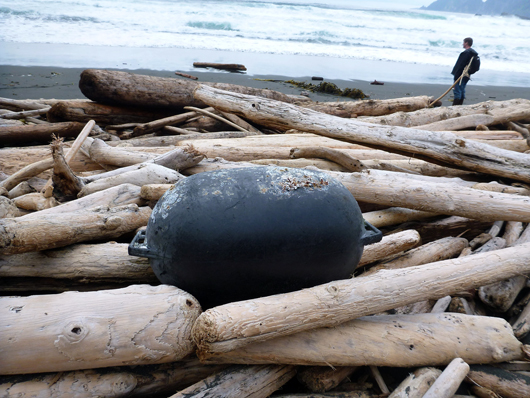Marine debris is nothing new, and a NOAA crew found little of note in last week’s survey of outside Panhandle beaches.
Beginning in Ketchikan, five scientists from the National Oceanic and Atmospheric Administration hit 36 sites, looking for debris from the March 2011 tsunami that hit Japan.
They mostly found common stuff, including a lot of Styrofoam. But large oval black, yellow and orange buoys turned up on 26 of 36 beaches.
“They were pretty ubiquitous throughout our survey area,” lead scientist Jacek Maselko said.
Maselko describes them as molded hard plastic with rings on either end. Some had English, some Japanese writing.
Jeep Rice of NOAA’s Auke Bay Lab, says they’re not fishing gear, and likely part of the Japanese fish farming industry.
“So the aquaculture farms with lots of nets and oysters and other things attached were swept up in the tsunami, and these would be the buoys that survived so to speak,” he said.
Rice said the buoys were about two feet in diameter and three and a half to four feet tall, and could support a lot of weight.
“These would be flying really high in the water so to speak, so they’re going to be easily taken by the wind and pushed by the wind further then say the water currents would take them,” Rice said. “Where there’s a conflict of the current versus air or current versus wide, these are going to be taken by the wind.”
The scientists also found a number of five-gallon jugs that appear to contain some type of waste oil. Some were empty, others broken up, some still had liquid contents. With no labels for a clue, Rice says the NOAA lab is trying to figure out what the substance is.
“One of them looks like of soapy-like. I don’t know if that’s maybe kitchen grease and soap, or oil, or did it come out of a transmission? We don’t know” Rice said.
While some notable things have washed up in the Pacific Northwest from the Japanese tsunami — such as a Harvey Davidson motorcycle, a dock, and the so-called ghost ship sunk in April by the Coast Guard — Maselko says most of the stuff the NOAA scientists catalogued may have been dumped in the ocean or found its way there years ago.
“We don’t know. Even finding a ball with name on it, you never know somebody just didn’t lose it playing beach volleyball in years past,” Maselko said. “That’s where the tough part of the proof comes in.”
The scientists will next survey beaches in the Yakutat area. Maselko says he intends to canvass as much of the Gulf of Alaska shoreline as possible this summer, looking for tsunami debris.


